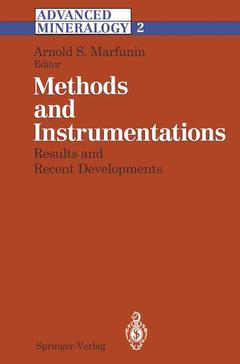Methods and Instrumentations: Results and Recent Developments, Softcover reprint of the original 1st ed. 1995 Advanced Mineralogy Series, Vol. 2
Langue : Anglais
Coordonnateur : Marfunin Arnold S.

All existing introductory reviews of mineralogy are written accord ing to the same algorithm, sometimes called the "Dana System of Mineralogy". Even modern advanced handbooks, which are cer tainly necessary, include basic data on minerals and are essentially descriptive. When basic information on the chemistry, structure, optical and physical properties, distinguished features and para genesis of 200-400 minerals is presented, then there is practically no further space available to include new ideas and concepts based on recent mineral studies. A possible solution to this dilemma would be to present a book beginning where introductory textbooks end for those already famil iar with the elementary concepts. Such a volume would be tailored to specialists in all fields of science and industry, interested in the most recent results in mineralogy. This approach may be called Advanced Mineralogy. Here, an attempt has been made to survey the current possibilities and aims in mineral mater investigations, including the main characteristics of all the methods, the most important problems and topics of mineralogy, and related studies. The individual volumes are composed of short, condensed chap ters. Each chapter presents in a complete, albeit condensed, form specific problems, methods, theories, and directions of investigations, and estimates their importance and strategic position in science and industry.
1 Systematics of the Methods of Investigation of Minerals: Logic of Development.- 2 Diffraction Methods and Crystal Structure Analysis.- 2.1 Crystal Structure Analysis and X-Ray Diffraction Instrumentation.- 2.2 X-Ray Diffraction Techniques for the Characterization of Minerals.- 2.3 Neutron Scattering, Neutron Diffraction: Hydrogen Location, Cation Distribution, Magnetic Structures.- 2.4 Electron Diffraction Analysis.- 3 Solid State Spectroscopy.- 3.1 Nuclear Gamma Resonance (Mossbauer) Spectroscopy.- 3.2 X-Ray and Photoelectron Spectroscopy of Minerals.- 3.3 Optical Absorption Spectroscopy.- 3.4 Luminescence of Minerals.- 3.5 Thermoluminescence and Exoelectron Spectroscopy of Minerals.- 3.6 Infrared Spectroscopy.- 3.7 Raman Spectroscopy in Earth Sciences.- 3.8 Electron Paramagnetic Resonance (EPR).- 3.9 Nuclear Magnetic Resonance (NMR) Spectroscopy.- 3.10 Nuclear Quadrupole Resonance (NQR).- 3.11 Muon Resonance. Application to the Study of the Hydrogen Atom Position in Quartz.- 4 Remote Sensing Methods: Visible, Infrared, and Microwave.- 5 Microprobe Analysis.- 5.1 Electron Probe Microanalysis.- 5.2 Trace Element Microanalysis by Proton-Induced X-Ray Emission (PIXE): The Proton Microprobe.- 5.3 Nuclear Microprobe and Microscopic Analysis.- 6 Electron, Acoustic, and Tunneling Microscopy of Minerals.- 6.1 Electron Microscopy of Minerals.- 6.2 High Resolution Acoustic Microscopy.- 6.3 Scanning Tunneling and Atomic Force Microscopy.- 7 Recent Developments in Analytical Methods in Mineralogy.- 7.1 General Overview of the Methods of Analysis of Minerals, Rocks, Ores, and Materials.- 7.2 Classical and Rapid Methods.- 7.3 Atomic Absorption Spectrometry.- 7.4 Inductively Coupled Plasma — Atomic Emission Spectroscopy.- 7.5 X-Ray Fluorescence Analysis.- 7.6 Neutron ActivationAnalysis.- 7.7 Nuclear Techniques for Uranium and Thorium Analysis.- 7.8 Mass Spectrometry.- 7.9 Inductively Coupled Plasma Mass Spectrometry.- 7.10 Ion Exchange Techniques.- 8 Isotopie Mineralogy.- 8.1 Radioactive Isotopes in Mineralogy and Geochemistry.- 8.2 Isotopie Systems in Geochronology.- 8.3 Noble Gas Isotopes in Planetary and Earth Minerals.- 8.4 Radiogenic Isotopes as Indicators of Sources of Mineral Matter.- 8.5 Light Stable Isotope Ratios as Indicators for Conditions of Mineral Formation.- 9 Computer Databases in Mineralogy.
Date de parution : 12-2012
Ouvrage de 441 p.
15.5x23.5 cm
Thèmes de Methods and Instrumentations: Results and Recent... :
© 2024 LAVOISIER S.A.S.



